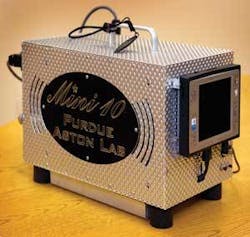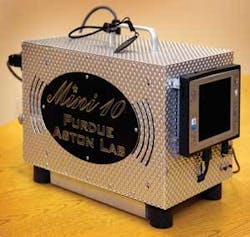Handheld instruments to transform explosives detection, environmental monitoring
By John McHale
WEST LAFAYETTE, Ind. - Researchers from Purdue University in West Lafayette, Ind., have developed battery-powered miniature instruments that one day could be deployed in wireless sensor networks in airports, subway systems, and office buildings.
Analytical chemists have used prototypes of the handheld mass spectrometers to detect minute traces of triacetone triperoxide, or TATP, which terrorists used in last year’s London subway bombings and is a common explosive found in improvised explosive devices.
“It’s one thing to detect a substance, but it’s another thing to be absolutely certain of its composition, which is what you get with mass spectrometry,” says R. Graham Cooks, the Henry Bohn Hass Distinguished Professor of Analytical Chemistry in Purdue’s College of Science.
“What we are talking about is something that monitors the environment in real time,” Cooks says. “This technology is practical because it is portable, rugged, and accurate.” Cooks also has developed a wand-like probe that can pass over objects to quickly analyze surfaces.
Mass spectrometry works by first turning molecules into ions-electrically charged versions of themselves-which are easily manipulated, detected, and analyzed based on their mass, Purdue researchers say. Scientists in Cooks’s lab have developed technology to speed up and simplify the use of a mass spectrometer, an analytical device that in its conventional form has been long established in modern laboratories.
The Purdue research team has constructed miniature versions of the normally large and delicate laboratory equipment, creating instruments that are lightweight, yield results in a matter of seconds, and are accurate enough for airport security and other homeland security applications, the researchers say.
Cooks’s research group has designed and built a portable instrument named the Mini 10 that is roughly the size of a shoebox and weighs about 22 pounds, compared to about 30 times that weight for a conventional mass spectrometer.
Researchers say they also envision future wireless networks linking many of the devices together to sniff the air constantly for chemical or biological warfare agents in buildings and critical locations such as subway stations and airports, Cooks says.
Conventional air monitoring methods involve collecting samples and then testing them in a laboratory.
Researchers using the Mini 10 have detected one nanogram-or a billionth of a gram-of TATP, which is about one-millionth the mass of a grain of sand. Such a system could alert security personnel to suspicious suitcases or packages because bomb makers handling explosives are likely to transfer minute chemical traces to the outsides of containers.
“TATP is difficult to detect with most other technologies,” Cooks says. The portable system also has detected other explosives, including TNT and plastic explosives.
“We really don’t know of any explosives that we can’t detect,” says doctoral student Justin Wiseman. “We started with TNT, went on to plastic explosives, then eventually to TATP.”
Materials are readily available to produce TATP, which terrorists have used in Iraq to make improvised explosive devices. The federal government has set aside tens of millions of dollars for research aimed at detecting TATP, Cooks says.
Cooks’s team is associated with several research centers at, or affiliated with, Purdue, including the Bindley Bioscience Center, the Indiana Instrumentation Institute, Inproteo (formerly the Indiana Proteomics Consortium), and the Center for Sensing Science and Technology. Griffin Analytical Systems, located at the Purdue Research Park, has the rights to commercialize miniature mass spectrometers and also will have a display in the conference exhibition.
Funding for Cooks’s research came from the National Science Foundation, Office of Naval Research, and Prosolia Inc., through the Indiana 21st Century Research and Technology Fund.

